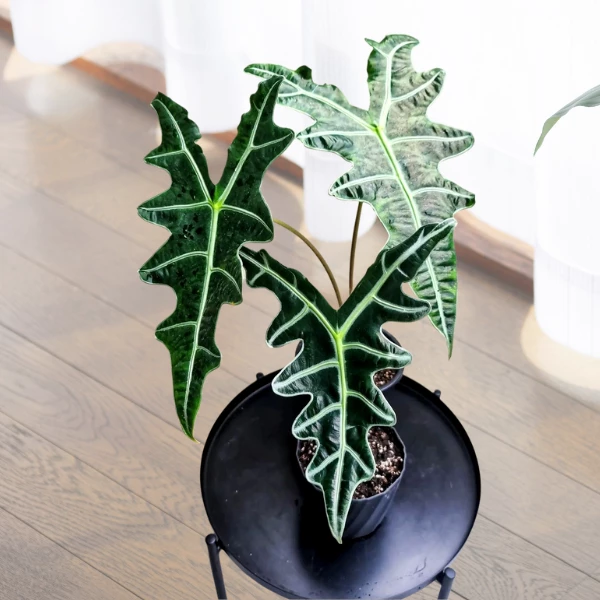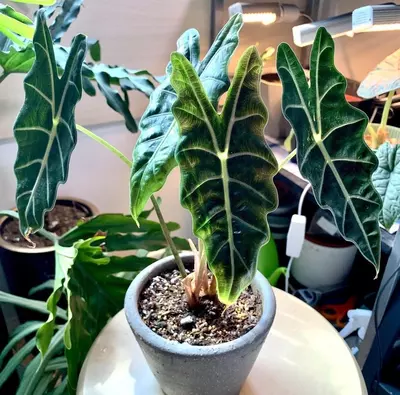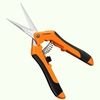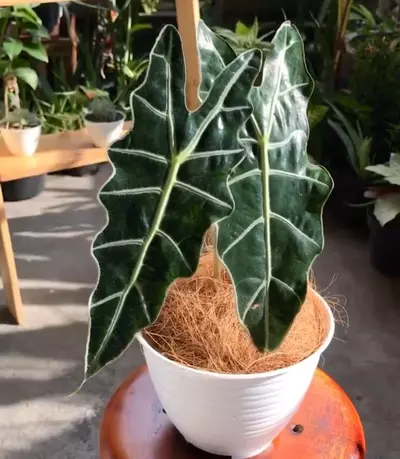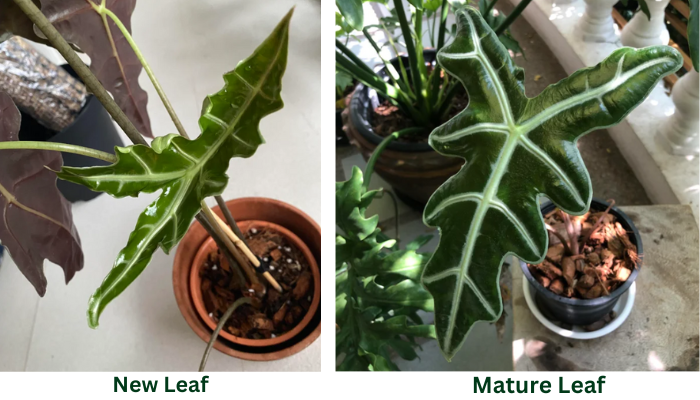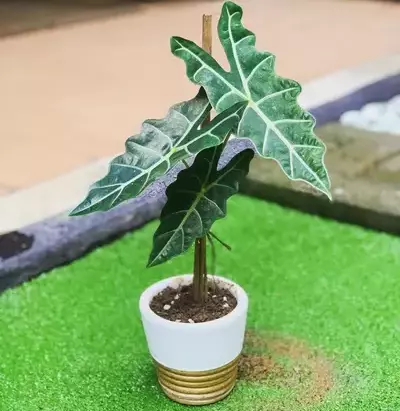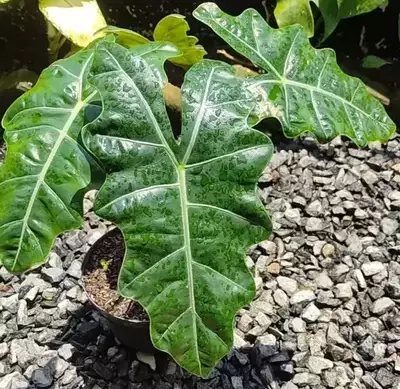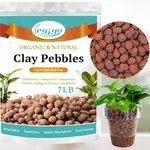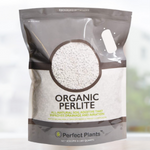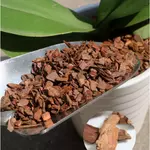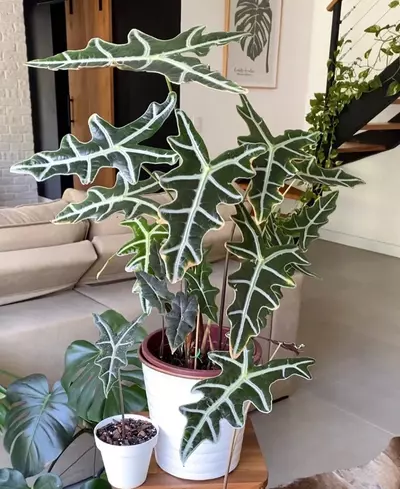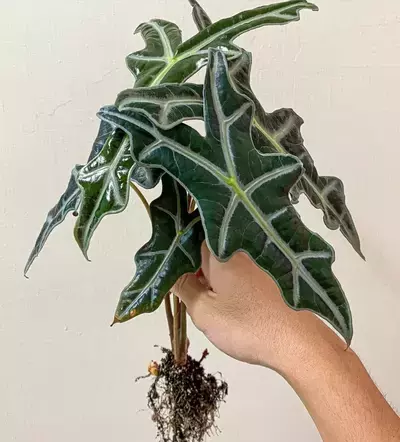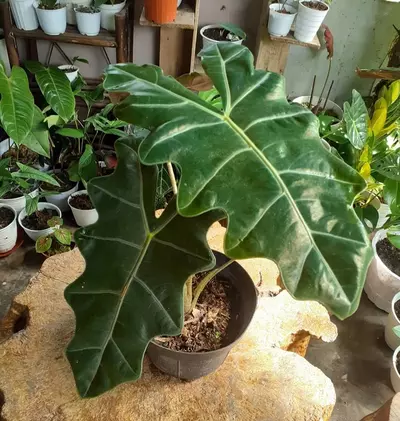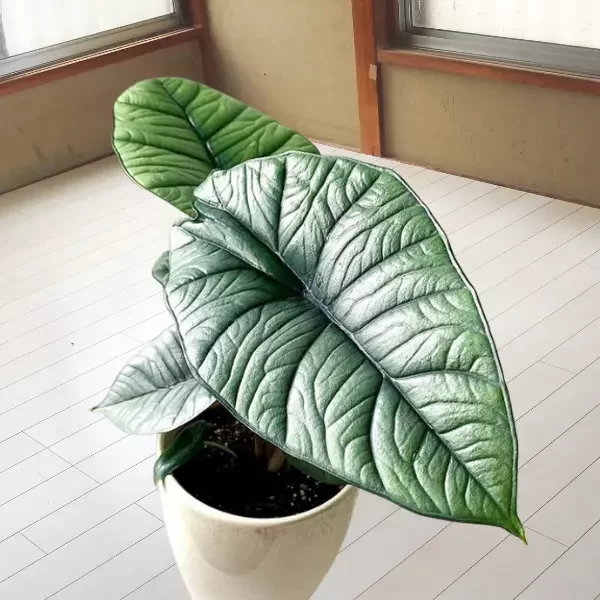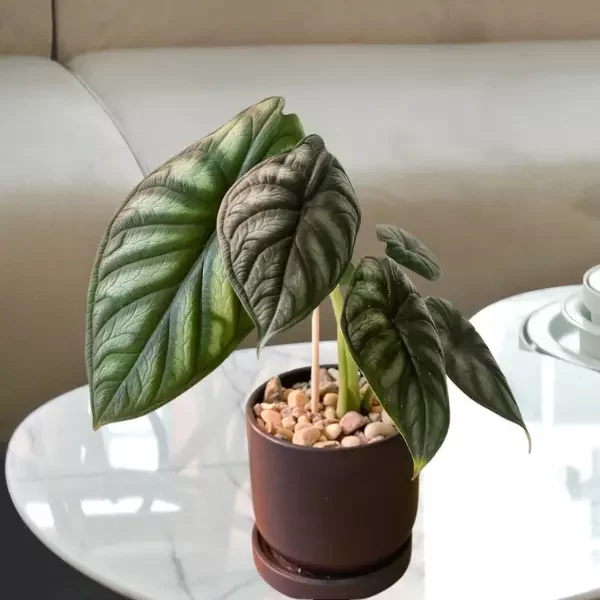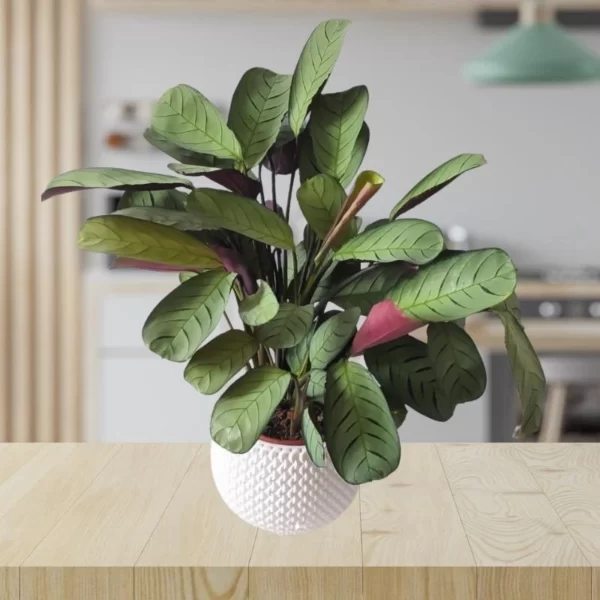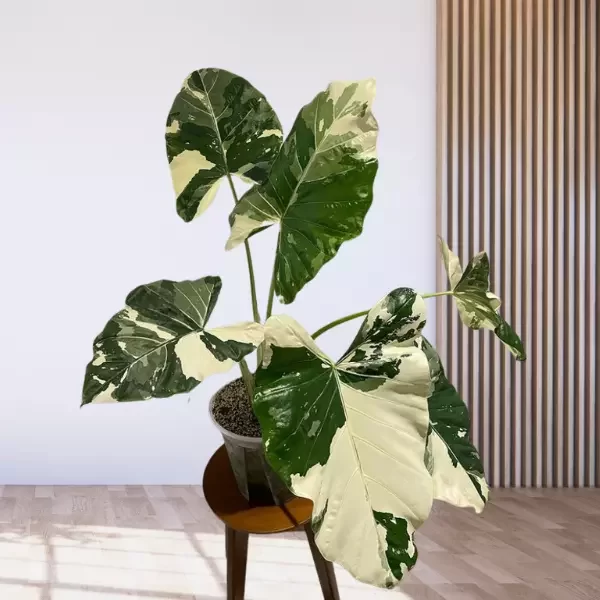Hello, plant parents!
Today is about one of my favorite plant the Alocasia Sanderiana which you would find in collections of plant enthusiasts and is commonly mistaken by Alocasia Polly, Amazonica and Bambino. Alocasia Sanderiana is one of the rarest of the rare Alocasia plants- a dramatic-looking houseplant adding a striking jungle vibe to any space with its peculiar, wavy silver-veined leaves. The unique alien-looking leaves are V-shaped with wavy edges and dark green colour, except for the contrasting white veins. The glossy and contrasting colours of the sagittate leaves with undulate margins are the main highlight of this beautiful plant- reminiscent of the wavy blade of the Kalis sword (also known as kris or keris- wavy-bladed dagger of Indo-Malay cultures). This distinctive-looking plant is known by other names, such as the Kris plant and Sander’s Alocasia.
Allied Species: Alocasia Polly, Alocasia Macrorrhiza Variegata, Alocasia Sarian, Alocasia Pink Dragon, Alocasia Cucullata, Alocasia Silver Dragon, Alocasia Stingray, Alocasia Regal Shields, Alocasia Nebula, Alocasia Jacklyn, Alocasia Zebrina.
How to Identify Alocasia Sanderiana?
While other Alocasia hybrids are frequently misidentified as this species, the real Alocasia Sanderiana can be distinguished by its narrow, arrow-shaped leaves with undulate margins sitting on ornamental petioles with vertical dashes subtended by cataphylls at the base.
Moreover, the Kris plant also has fewer leaf lobes and lateral veins (i.e. usually 4-6), produces only 1-4 leaves per plant, slow-growing, and enters a long period of dormancy (approx. two months). This silver-veined Alocasia got the fame as it is one of the parents of Alocasia Amazonica, hence the archetype of white-veined Alocasias. This specie is part of a group known as the “Longiloba group”.
Essential Products
Habitat & Ecology
This beautiful houseplant is native to the island of Northern Mindanao in the Philippines and was named after German-born orchidologist Henry Frederick Conrad Sander (1847-1920). It is classified as Critically Endangered in Philippine by IUCN and can be found in collections, however tissue culture specimens are now available at different nurseries to grab. It is a sensitive plant and craves the tropical climate to prosper.
| Botanical Name: | Alocasia Sanderiana |
| Family Name: | Araceae |
| Common names: | Kris plant, Sander’s Alocasia |
| Origin | (Mindanao) Philippines |
| Variants | Alocasia Sanderiana Nobilis, Alocasia Pseudo Sanderiana |
| Plant Size | 2 to 3 feet |
| Temperature | 60F-80F |
| Humidity | 60% and above |
| Light Need | Bright indirect sunlight- Partial shade to full sun |
| Soil Type | Moist but well-Drained |
| Flower Inflorescence | Insignificant Green and White inflorescence followed by orange-red fruits |
| Propagation | Offset Division, Corms |
| Pest and diseases | Spider mites, Aphids, Scale, mealy bugs |
| Diseases | Root rot, Root rot, leaf spot |
How do you care for Alocasia Sanderiana?
Although the Kris plant needs a little more care and attention, it is relatively easy to grow but more difficult than growing either Alocasia. Pseudosanderiana or ‘Amazonica’. Due to its tropical habitat, Sanderiana needs consistent moisture. It loves moist soil but doesn’t like to be soaked in water. That being said, the plant also benefits from high humidity and warm temperature. In addition, the bright indirect light helps the plant to grow fast and healthy.
This article got a total rundown of everything related to Sanderiana’s care and growth to help this tropical beauty thrive, including light, soil, water needs, propagation tips, and more. So keep reading below to learn about this stunning beauty’s growth and care tips.

Growth
The beautiful Kris plant can grow up to 2 to 3 feet indoors, provided the natural habitat environment. The arrow-shaped leaves are 12–16 in (30–40 cm) long and 15 to 20 cm wide, offering an appealing visual due to the plant’s upright growth. However, in nature, the Sanderiana exhibit a range of variations in leaf shape, abaxial coloration, and venation. Hence, you would observe a diverse morphology of wild Kris plants compared to the TC version in cultivation.
The plant is a slow-growing Alocasia, usually exhibiting two leaves per plant and sometimes four when the plant is happy. The leaf lobes are from four to rarely seven, following the same number of lateral veins running to the margins of the leaves. Alocasia Sanderiana doesn’t grow runners frequently; hence never appears full of foliage.
Moreover, the new leaves emerge light green doesn’t have much contrast between the veins and green leaf. However, when the plant leaves mature, the white venation become more apparent contrasting glossy, dark green foliage . The growth slows down when the temperature drops and usually this plant can go to dormancy for two months.
Sanderiana produces insignificant white-creamy and green flowers refer as inflorescence which produce bright orange fruits when pollinated. However Kris plant is prized for its glossy, dark green lobed foliage, contrasting prominent, silvery white venation.

Initial Care at Home
First thing after bringing Alocasia Sanderiana is to quarantine it for two to three weeks to ensure no pest infestation or diseases. Shower the leaves to eliminate dust and thoroughly inspect the foliage before introducing it to other plants in your collection. Please don’t rush repotting your Sanderiana unless necessary, and let it acclimate to its new environment.
When you bring Kris plant home, place it in an area where it receives bright but indirect light and high humidity.

Light Need
The Kris plant’s has tropical habitat where they grow tree canopies, and their petioles extend towards the light direction. The Alocasia Sanderiana thrives in bright indirect, or filtered sunlight. However, it can’t endure direct sunlight, and exposure to direct light results in leaf burn and discoloration.
As this plant needs bright indirect sunlight, it should be placed at locations both indoors and outdoors where it doesn’t receive intense direct light. Place Alocasia Sanderiana in a spot where it gets maximum indirect light, like an east or south-facing window. Moreover, when growing outside, choose a sheltered spot for the kris plant to prevent scorching leaves. Also, ensure regularly wiping the leaves to eliminate dust to enhance their light-capturing efficiency.
Similarly, placing your Kris plant in spots where shade predominates, the petioles extend, searching for light resulting in a slender stem, small leaves, and a lopsided plant. Due to a lack of light, the plant doesn’t absorb the water entirely and becomes susceptible to root rot due to soggy soil.
My Alocasia Sanderiana tend to prefer medium light rather than bright, indirect. The leaves started getting bright green spots when I put it in a brighter area. Please choose a bright location for your lovely Kris plant wisely, where it can enjoy its growth.
Alocasia Sanderiana may stress out and drop leaves without ample sunlight. Moreover, the plant may go to dormancy under low light conditions. If you don’t have bright spots, using grow lights would benefit this plant to receive the required light.

Watering
The Kris plant likes moderate watering; it appreciates constantly moist soil but, at the same time, doesn’t like to sit in water for long periods. Therefore, the watering frequency should be modest for Alocasia Sanderiana. Remember, watering frequency depends on several factors, such as light intensity, temperature, and soil composition.
My Alocasia Sanderiana is potted in terracotta into a chunky aroid mix, so I usually water it once a week. I live in a pretty humid environment with a lot of rain around the year, so I don’t worry too much if I underwater it. In hot weather, the plant’s thirst increases and needs frequent watering, while in cold weather, it takes longer for plants to absorb all the water; therefore needs less frequent watering.
It is best practice to check the soil moisture before watering, using fingers or moisture meter. If the top two inches of soil fees dry, your plant is thirsty and need water.
Watering is a critical aspect of Alocasia Sanderiana care, as it can suffer from infrequent watering. When the plant is overwatered, it can catch many fungal infections, including root rot which can be deadly. On the other hand, dehydration can hinder plant’s growth. Although succulent stems of Alocasia Sanderiana can hold water, but are intolerant to extended periods of dryness that may lead leaves turning brown and a leaf drop.
For adequate watering, use a well-draining, moist, and aerated potting soil and only re-water the plant when the topsoil dries, but don’t let your plant get bone dry.

Humidity and Temperature
Alocasia Sanderiana loves constant moisture because of its tropical nature. It can’t survive in a dry environment; hence, high humidity levels are indispensable for its healthy development. This plant does well in 60% and above humid atmospheres; if the humidity is below 60% at your home, try to surge its levels with the help of a humidifier and pebble tray. Regular misting is also another option to level up humidity.
The ideal temperature range for your lovely Sanderiana is 60 degrees Fahrenheit to 80 degrees Fahrenheit. Although it can tolerate little fluctuations in temperature, it can’t thrive but only survive if it’s kept in an undesired temperature for too long. The plant can’t endure cold and should be kept indoors in cold weather. Additionally, the delicate Kris plant can’t stand cold drafts; therefore, it should be placed in warmer areas.
Moreover, keep the plant away from AC vents, heaters and frosty windows as it is not tolerant to abrupt temperature variations. When the temperature drops, it is a good idea to bring the plant inside to continue as a houseplant.

Soil
Alocasia Sanderiana requires moist but chunky and well-draining soil mixture. A well-aerated soil is vital for Alocasias to avoid diseases such as root rot and fungal infections. To attain desired results in the soil, we recommend making a an organic rich potting mix with plenty of chunky components.
Recipe
To prepare a potting mix, you will need all main ingredients in equal amounts.
Alocasia Sanderiana is a great candidate for semi- hydroponics such as LECA and PON growing mediums. Growing in semi-hydroponics reduces the chances of over-watering and root rot. We recommend using a self-watering planters for Leca and Pon to grow Alocasia Sanderiana.
However, if you don’t want to prepare the soil mixture, we highly recommend checking the following ready-made potting mix;
Related Products
Products | Name | Check Price |
Organic Perlite for Plants | ||
WONDER SOIL Organic | ||
Orchid Potting Bark Mulch |

Repotting
The Kris plant likes to be compact in the pot; that’s why repotting isn’t required that often. But you should repot the plant every 2 to 3 years, depending on its growth. The significant sign that your plant likes to be transplanted is when the roots start bulging out from the drainage holes and plant needs frequent watering.
The best time to repot the sanderiana is spring because it’s a growth season, and the plant can tolerate the transplant shock and recover quickly to grow in a new container.

Propagation
Like most Alocasias, there are many methods to propagate Sanderiana, such as through seeds, corms and the offset division method. It is best practice to water the soil 24 hours before propagating to reduce transplant shock.
Offsets Division
Alocasia Sanderiana produces runners aka suckers or offsets that shoot out from the main plant and can be grown as an independent plant once divided from the main plant.
Follow the step-by-step guide.
Alocasia Sanderiana can also be propagated through seeds that the inflorescences produced when pollinated, but it’s a time taking propagation method.
Corm Propagation
Another successful propagation method is through corms. Kris plants tend to produce corms or bulbs in their roots as they mature. These corms, when hardened, come off the roots and roll in the potting mix. You can collect these corms from the soil or pluck them from roots during repotting. The key is to pick the firm corms for successful new plant growth.
Once you collect all the corms, you can root them in several ways using different growing mediums such as water, Leca clay balls or sphagnum moss. Take a container, fill some water, or put some leca or sphagnum moss, and place the corms on them. In the case of water, use the shallow puddle method, and for Leca and sphagnum moss, don’t bury the corms in them. Once you notice some roots and sprouts, you can plant them in an aroid potting mix to grow as independent plants.

Maintenance and Pruning
Like all other Alocasias, the Kris plant also likes to be maintained. While it isn’t a high-maintenance plant but pruning is important to maintain its shape and health. Trimming is also required to remove dead and old leaves. Regular pruning not only keeps the plant in an attractive shape but also encourages its growth. Prune the plant in early summer or spring to give it enough time to the plant to recover. Always wear gloves and use disinfected scissors or shears to avoid any infections.
Moreover, wiping the leaves every other week will reduce the likelihood of pore blockage, and the plant will continue to photosynthesize efficiently. Don’t forget to rotate your Sanderiana plant every few weeks to let plant grow equally from all sides and prevent plant from leaning towards light source.

Fertilizer
Over time the nutrients in the potting mix start to deplete and Sanderiana may benefit from the additional nutrients in the growing season; thus, fertilizing the plant is essential for new and larger foliage. However, this Alocasia needs to be fed once a month in the spring season only; therefore, stop fertilizing it in cold weather as the plant stops growing and doesn’t need extra nutrients. However, if you notice any growth or pup coming out don’t hesitate to fertilize your plant in winter.
Use any Nitrogen-based balanced liquid fertilizer with half the strength to feed your plant. A water-soluble balanced fertilizer is another alternative for Kris Alocasia; always use half the dose than recommended because too much fertilizer may burn the roots. Moreover, feeding granular slow-release fertilizer once a month also benefits the plant- I prefer to use granular fertilizer to avoid root or foliage burn. It releases nutrients slowly when the plant is watered.
If you want something organic for Alcasia Sanderiana, using liquid dirt, worm castings or fish emulsion sure will benefit the plant.

Toxicity
Unfortunately, like other Alocasias, the stem and leaves of Alocasia sanderiana carry high levels of calcium oxalate crystals that are highly poisonous to humans and pets. Swelling in the mouth, lips, and throat are some common side effects, while skin irritation and vomiting can also occur in severe cases. So, keep the plant away from kids and pets. As a result of consumption, seek immediate medical help.

Pests, Diseases & Common Problems
Pests
Although Alocasia Sanderiana is toxic to humans and pets, but it serves a good home for pests such as Spider mites, Aphids, Scales, and Mealy bugs. Pest infestation in Alocasias is quite common, and some significant signs are white residue on the leaves, curled, twisted and discolored leaves, and webbing on the plant foliage.
Keeping a high humidity level to keep alocasia Sanderiana happy also will help prevent pest infestations as low humidity fosters the development of certain pests like spider mites.
When this happens, isolate your plant and use neem or insecticidal oil to spray the leaves to kill pests and their eggs. You can also polish the leaves with a warm diluted solution of neem oil and soapy water. Neem oil benefits Alocasias as it acts as a natural pest repellent. Also, don’t let the plant surroundings dry; keep the humidity level high to prevent pest outbreaks.
Moreover, wiping the leaves regularly with a soft cloth damped in warm dishwasher soap water also helps eliminate pests and prevent spreading.
Diseases
The Kris plant is a delicate loveliness and is susceptible to several diseases, including root rot, fungal infection and leaf spot.
Leaf spots
The leaf spot is caused by the bacteria Xanthomonas. When you notice the marks on the leaves, isolate your plant, remove infected leaves, and change the potting soil. If the leaf spot is left untreated, it can slowly kill your plant.
Fungal Diseases
Fungal pathogen spores such as Botrytis and powdery mildew may germinate due to moisture and lack of airflow to the leaves. you must stop misting your plant in case of bacterial or fungal infections. How might one know if the Alocasia plant has a bacterial or fungal infection?
Well, soft, dark-brown spots on the leaves are a symptom, and you must stop misting your plant. Moreover, powdery residue on the leaves or stems is a symptom of powdery mildew exacerbated by high humidity and leaves not getting enough airflow to dry out. An immediate remedy is to stop misting to prevent the spread. Instead, use a humidifier and place a plant in a spot with enough air flow.
Root rot
Another lethal disease that may kill your lovely Kris plant is root rot. The leading cause of root rot is overwatering. The general signs of root rot are yellowing of leaves and black mushy roots. If you suspect root rot on your plant, remove it from the pot to check the roots and remove the infected parts. Then, plant the Sanderiana in a new pot with a fresh potting medium.
Common Problems
Alocasia Sanderiana is a sensitive plant and is prone to various problems. The common issues that this plant can experience are
Yellow leaves:
This problem is mainly caused by watering or light issues. Make sure that your plant gets an adequate amount of water. Don’t water the plant if the top two inches of the soil are moist to avoid overwatering; likewise, don’t leave the soil to dry out completely to prevent dehydration.
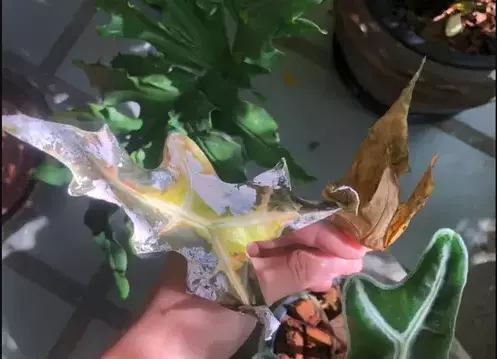
Too dense potting soil or too large pot also keep the soil soggy leading to root rot and yellowing of leaves. Insufficient light is also responsible for the yellowing of leaves; when you spot yellow leaves on the plant, keep your plant in bright indirect light so that it can photosynthesize efficiently and drinks all the water from the soil.
Dying off leaves:
It’s normal for Alocasia to enter dormancy in the winter season, that cause leaves to die off. If you notice the leaves are dying in cold weather, don’t panic, as its common for this species to shed off leaves in colder months. Moreover, Alocasias drop off leaves to grow new ones. Alocasia Sanderiana may bear 4 to five leaves at a time.
But it’s a matter of concern if the leaves are dying in the growing season, leading to a one or two-leaf plant. It can be due to several reasons, such as inadequate humidity, low light, and improper. In that case, evaluate the plant’s care and make required adjustments accordingly.
Sun Damage:
The Alocasias Sanderiana can’t withstand direct sunlight except for the low-intensity early mornings and late evenings sunrays. If your plant is exposed to direct light, it can cause sun damage, resulting in dehydration of the plant and yellow and white spots on the leaves. Moreover, the intense sunlight can scorch the plant’s foliage. Move the plant a few feet away from the window or glass door, or use curtains to filter out light for the Kris plant.
Dry, crispy leaves:
These are signs that the plant doesn’t receive enough humidity and a lack of moisture in the air. In such cases, elevate the moisture by placing a humidifier or pebble tray near the plant or grouping your plants.

Frequently Asked Questions
Is Alocasia Sanderiana rare?
Alocasia Sanderiana is a beautiful and peculiarly unique houseplant that can be a perfect fit for any household. It is a rare plant similar to Alocasia Amazonica except for the deeply cut foliage.
Is Alocasia Sanderiana indoor plant?
Alocasia sanderiana is a fast-growing Alocasia that is mostly grown indoors. However, it can also be kept outdoors in the summers to provide proper humidity and temperature.
What is the common name of Alocasia Sanderiana?
The sanderiana belongs to the family of Araceae, and its commonly known as the Kris plant or Sander’s Alocasia.
How do you grow Alocasia Sanderiana?
The Alocasia sanderiana belongs to the tropical regions. You can easily grow this plant by mimicking its natural habitat by providing bright indirect light, warm temperature, higher humidity, and well-draining soil.
How do you make Alocasia happy?
You can keep Alocasia happy by providing it with bright indirect light, warm temperatures, and high humidity levels. As a result, the plant is pleased when it gets well-draining, moist soil and receives water only when needed.

Final Words
The Alocasia Sanderiana is a unique and ultra-rare variety of the Araceae family that makes a gorgeous houseplant. It’s a unique-looking wavy margined beautiful plant for indoor plant collection and gardens that can catch the attention of many.
Kris plant doesn’t need high maintenance, but it can still be challenging for beginner gardeners because of its tropical needs. However, this plant can bloom if provided with the proper growth conditions, such as adequate light, watering, and humidity.
We have developed the complete care guide to help you grow your elusive Alocasia Sanderiana with love and all-knowing so that it can reward you with its remarkable foliage.
Happy Gardening!!
Related Posts
Alocasia Bisma | Care Guide for Alocasia Platinum
Alocasia Bisma is a distinguished member of Araceae family. It is also commonly known as Emerald Dragon Scale and Alocasia Platinum.
Alocasia Baginda Dragon Scale | Jewel Alocasia Care
Alocasia Baginda Dragon Scale- an exquisite Jewel Alocasia. exhibits incredible textured foliage that look like the Dragon Scale.
Ctenanthe Burle Marxii Amagris | Never Never Plant Care
Ctenanthe (pronounced te-NANTH-ee) Setosa ‘Grey Star’ of the Marantaceae family is an attractive and vibrant plant.
Alocasia Macrorrhiza Variegata | Elephant Ear Plant Care
Alocasia Macrorrhiza Variegata is a striking beauty exhibiting gigantic, variegated foliage marbled with tones of light green and white blotches.
Alocasia Calidora | Elephant Ear (Persian Palm) Care
Alocasia Calidora is a cultivar featuring large ruffled edged attractive leaves. Owing to large foliage got the name ‘Calidora’ Elephant ear.

